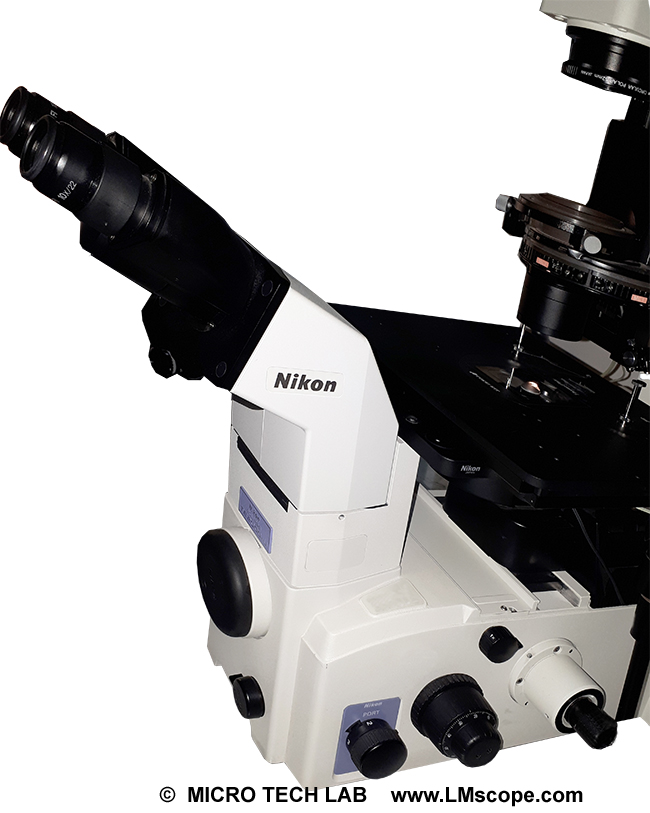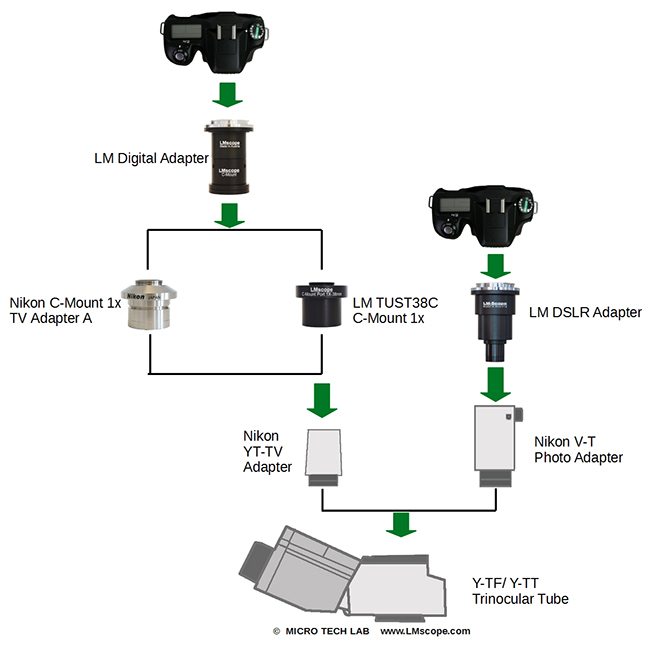

Nikon Eclipse TE2000: Combined with state-of-the-art camera technology, this microscope series delivers top-level image quality
The microscopes of the Nikon Eclipse TE2000 series feature a multiport design, which enables easy integration of commercially available DSLR and DLSM cameras (system cameras). Our LM adapter solutions make attaching a camera to a TE2000 microscope an easy task and deliver superior image quality.

The Nikon Eclipse TE2000 universal microscope with infinity optics was developed primarily for live cell examinations and offers a comprehensive range of accessories. The largely motorised microscope is equipped with the renowned Nikon CFI60 optics and permits operation with multiple light sources.
The TE2000 is available in three configurations that each focus on different key aspects:
- TE2000-S: basic model with multiple optical accessories, equipped with two output ports
- TE2000-U: comes with 4 output ports as standard
- TE2000-E: motorised and vibration-free mechanism for image capture in 3D, 5 output ports
Depending on the tube/port, different adapter solutions are required for connecting a camera to the microscope. The type of camera (bayonet mount) and the sensor size also need to be taken into account.
The Y-TT and Y-TF trinocular tubes are suitable for our setup.

Now we need to take the following considerations into account:
- The Nikon V-T photo adapter is slightly longer and has an internal diameter of 42 mm. The LM DSLR adapter is directly attached to that photo adapter.
- The Nikon V-T TV adapter is slightly shorter and has an internal diameter of 38 mm. This adapter accepts either the TUST38C LM C-mount adapter or – if you already have one – the Nikon C-mount 1x adapter. The LM digital adapter, which is connected to the camera, is then added to that combination.
The 38 mm side port can also be used to attach DSLR/DSLM or C-mount cameras to the microscope. For this, either the LM TUST38C C-mount adapter or the LM DSLR adapter (depending on the camera) is required.
Each of the three TE2000 models supports all common microscopy techniques: epi-fluorescence, fluorescence, phase contrast, Nomarski DIC, and Hoffman modulation contrast. Different illumination options can be used simultaneously – with just one mouse click, the user can switch back and forth between them. The microscope was developed to withstand long-term thermal fluctuations for gene detection purposes.
Of course, the TE2000 microscopes were also designed with ergonomic functionality in mind: easily accessible control elements, a working distance that can be extended up to 800 mm (plus 57 mm with stage risers), ergonomic tubes and eyepiece extensions make microscope work more comfortable. Thanks to an extensive range of accessories (double lamp house, thermal plate warmer, incubator, teaching heads, intermediate tube for Eclipse E600/400 trinocular tubes), the TE2000 microscopes can be customised to individual needs. With a weight of 32 to 40 kg and a price of over EUR 10,000 per instrument, the Nikon Eclipse TE2000 series plays an important role in the high-end segment of the industry.
Conclusion:
The TE2000’s selection of different output ports and its powerful optical system make this high-quality universal microscope a great fit for photomicrography. In addition, our LM digital adapters with plan achromatic precision optics make it possible to combine the microscope with almost any type of DSLR and DSLM/system camera.
Photography:
Fitting the microscope to digital single-lens reflex (DSLR), mirrorless interchangeable-lens cameras (MILC ), digital single-lens mirrorless (DSLM) or C-mount cameras is easy with our LM digital SLR adapters, which feature a plan achromatic optical system. Our products make it possible to capture top-quality microscope images. To help you select the adapter that is right for your camera, we have set up an online configurator on our website. You can also email us – ideally with attached photographs of your microscope.
Modern DSLR and single-lens mirrorless (DSLM) offer the latest technology and are generally very well suited for microscopy applications. Most of them can be controlled remotely via PC/Mac. Because of their high sales volumes, they offer an excellent price/performance ratio compared to special-purpose microscope cameras.
Features of top DSLR and single-lens mirrorless cameras (DSLM):
- Large, powerful full-frame sensors (36 x 24 mm)
- Sensor resolution of 61 megapixels or 240 megapixels with Pixel Shift technology
- High light sensitivity (ISO 400,000+)
- Extensive dynamic range (up to 15 aperture stops/f-stops)
- Short exposure times (1/8000 second) up to 1/32,000 seconds using the digital shutter
- 4K Ultra HD or 8K Ultra HD video function
- Live video capture on external monitors in ultra HD quality
In most cases, these cameras are significantly more powerful than microscope cameras with smaller sensors (1/2" or 2/3"). On our website you will find our current camera recommendations and a camera ranking which is specifically tailored to microscopy applications.
New LM Digital Adapter for: Sony Alpha 9 III / Nikon Z9 / Nikon Z8 / Sony Alpha 7R V / Sony Alpha 1 II / Sony Alpha 1 / Sony Alpha 9 II (ILCE-9M2) / Sony FX3 Cinema Line / Sony Alpha 9 / Nikon D6 / Canon EOS R3 / Canon EOS R6 Mark II / Canon EOS R8 / Sony Alpha 7R IV / Canon EOS R5 II / Nikon Z6III / Canon EOS R5 / Sony Alpha 7S II / Sony Alpha 7S III / Sony Alpha 7R III / Canon EOS R6 / Nikon Z6 / Nikon Z6II / Sony Alpha 7R II / Nikon Z7 / Nikon Z7II / Canon EOS R / Canon EOS Ra (Astro) / Nikon Z5 / Sony Alpha 7C / Canon EOS RP / Sony Alpha 7S / Canon EOS R7 / Leica SL2-S / Canon EOS R10 / Nikon Z50 II / Canon EOS 1D X Mark III / Nikon Z50 / Nikon Z30 / Nikon Z fc / Nikon D850 / Canon EOS 1D X Mark II / Nikon D780 / Olympus OM-1 / Sony Alpha 7III / Olympus OM-D E-M1 Mark III / Canon EOS R100 / Sony Alpha 6700 / Nikon D5 / Sony Alpha 6600 / Fujifilm X-H2S / Fujifilm X-S10 / Fujifilm X-E4 / Fujifilm X-Pro3 / Olympus OM-D E-M1X / Sony Alpha 6400 / Sony Alpha 6100 / Sony ZV-E10 / Canon EOS 1D X / Nikon D4s / Olympus OM-D E-M5 III / Canon EOS 90D / Canon EOS 5D Mark IV / Nikon D4 / Nikon D750 / Canon EOS 6D Mark II / Fujifilm X-T5 / Fujifilm X-T4 / Fujifilm X-T3 / Sony Alpha 6300 / Sony Alpha 6500 /